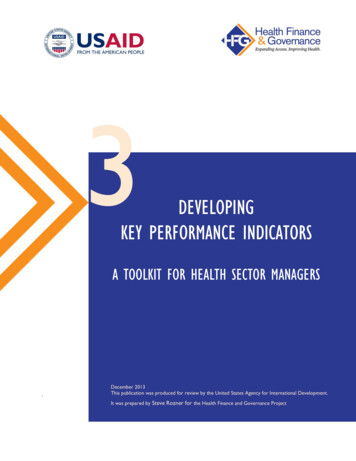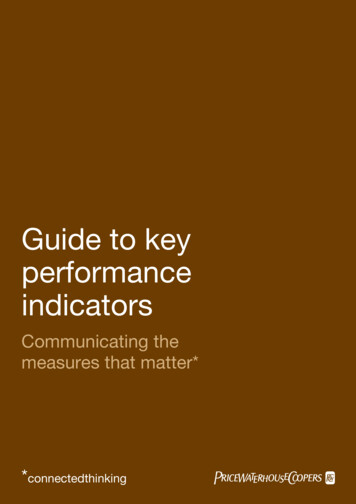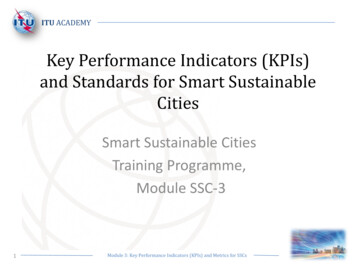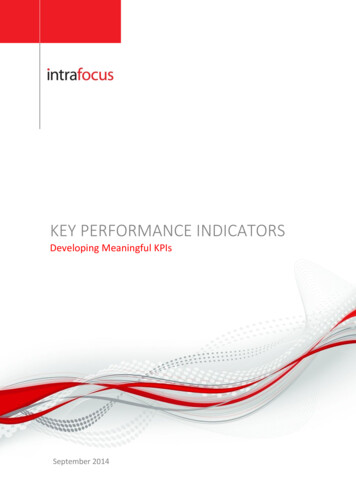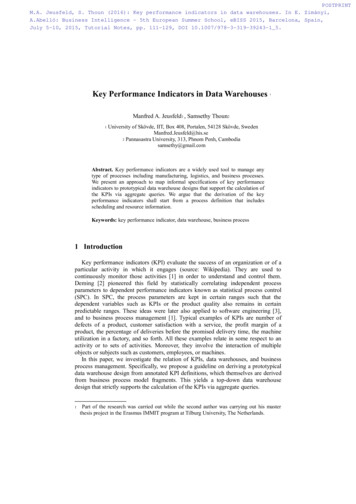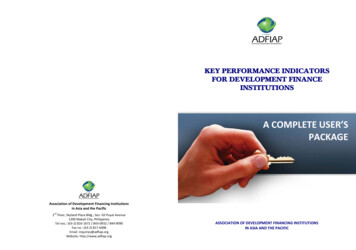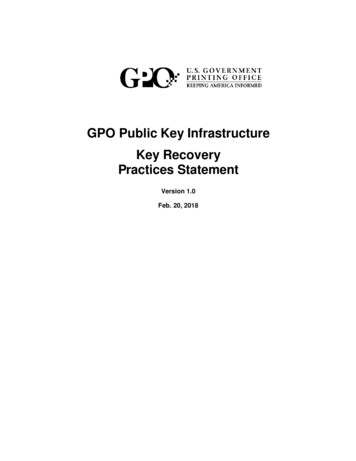
Transcription
Key Performance IndicatorsListed by Sector
Table of ContentsWhat are Key Performance Indicators? . 2KPIs by Discipline . 3Human Resources . 3Financial . 4Customer Service . 7Marketing . 8Sales . 9Information Technology . 10KPIs by Sector . 12Accommodation and Food . 12Construction . 14Education . 15Finance and Insurance . 18Healthcare and Social Services . 22Manufacturing. 26Professional Services . 28Retail . 30Transportation and Warehousing . 34Utilities . 35Wholesale Trade . 371 Page
What are Key Performance Indicators?A Key Performance Indicator or KPI is a term used in industry to describe a wayin which we might measure performance. Organisations commonly use KPIs toevaluate success in a particular activity in which it is engaged. Sometimes the‘success’ is defined in terms of making progress towards a strategic initiative orgoal and at other times the repeated achievement of an operational goal. Thething that makes a KPI special or different to a simple measure or metric is thatit is ‘key’ to the success of the activity. This inevitably leads to the conclusionthat ‘Key’ Performance Indicators are important and few. How few dependson many things including the type of business, the nature of the activity andthe level of control required.However, whereas a large organisation may quite reasonably have hundreds ofmeasures in place it should only have tens of KPIs. In many quarters, there is aview that the fewer the KPIs the better but there is a balance here. Too fewKPIs lead to a measurement at too high a level and therefore an inability toinfluence the activity and resultant goal. For example, whereas a KPI of‘Increased Profitability’ is laudable, without a set of clearly defined initiativesand further KPIs at appropriate levels it is simply and after-the-event measure.It is therefore important to select KPIs carefully and have the right mix of ‘lead’measures i.e. those things that can be measured before the event and arebelieved to influence the event, and ‘lag’ measures i.e. those things that provethe event has occurred. A very common method used to compile the right setof KPIs is to apply a management framework such as the Balanced Scorecard.Having said that the KPI approach should look at a few important measures,the list of measures available in any given discipline or industry is huge. Thereare a number of commonly used KPIs, the following sections of this documentprovide starter sets in various areas.2 Page
KPIs by DisciplineHuman ResourcesActual versus budgeted cost of hireAnnualized voluntary employee turnover rateAnnualized voluntary turnover rateAverage headcount of employees each human resources (HR) employeeworking is caring forAverage interviewing costsAverage length of placement in months for the managerAverage length of service of all current employeesAverage length of service of all employees who have separatedAverage month’s placementAverage number of training hours per employeeAverage number of vacation days per employeeAverage performance scores of departing employeesAverage retirement ageAverage salaryAverage salary for all employees reporting to the selected managerAverage sourcing cost per hireAverage time employees are in same job/ functionAverage time to competenceAverage time to update employee recordsAverage training costs per employeeCompensation cost as a percentage of revenueContingent workersEmployee satisfaction with trainingEnd placementsFemale to male ratioFull-time employees (FTEs) per human resources (HR) department FTEHeadcount of contingent workers for the managerHR average years of service (incumbents)HR average years of service (terminations)HR department cost per FTEHR headcount: ActualHR headcount: Available3 Page
HR to employee staff ratioJob vacancies as a percentage of all positionsNew hire qualityTime to fillHiring manager satisfactionCost per hireStaffing efficiencyInternal, external, and total headcount recruiting costs and ratiosNumber of end placements made in the reporting period for the managerPart-time employees as a percentage of total employeesPercentage of employees receiving regular performance reviewsPercentage of employees that are near or at max for their vacation balancesPercentage of HR budget spent on trainingPercentage of new hire retentionRatio of internal versus external trainingRatio of standard level wage to local minimum wageReturn on investment (ROI) of trainingTotal overtime hours as a percentage of all work hoursTraining penetration rate (percentage of employees completing a coursecompared to all FTEs)Workforce stabilityFinancialAccounting costsAccounts payable turnoverAccounts receivable collection periodAccounts receivable turnoverActual expensesAmount due (per customer)Average customer receivableAverage monetary value of invoices outstandingAverage monetary value of overdue invoicesAverage number of trackbacks per postBudget variance for each key metricBudgeted expenses4 Page
Capital expendituresCash conversion cycle (CCC)Cash flow return on investments (CFROI)Cost of goods sold (COGS)Cash dividends paidCost per pay slip issuedCreditor daysCurrent receivablesCumulative annual growth rate (CAGR)Cycle time for expense reimbursementsCycle time to process payrollCycle time to resolve an invoice errorCycle time to resolve payroll errorsDays payableDebtor daysDirect costDiscounted cash flowEarnings before interest and taxes (EBIT)Earnings before interest, taxes, depreciation (EBITDA)Economic value added (EVA)Employee available timeEmployee scheduled timeEmployee work centre loadingEnterprise value/ takeover valueExpense account credit transactionsExpense account debit transactionsExpense account transactionsFixed costsGross profitGross profit marginIndirect costsInventory turnoverInventory valueInvoice processing costsInternal rate of return (IRR)5 Page
Market share gain comparison percentageNet change in cashNet incomeNet present value (NPV)Number of invoices outstandingNumber of unapplied receiptsNumber of past-due loansOpen receivablesOpen receivables amount (per customer)Operating leveragePast-due receivablesPayables turnoverPayment errors as a percentage of total payroll disbursementPercentage accuracy of financial reportsPercentage of bad debts against invoiced revenuePercentage of electronic invoicesPercentage in dispute (per customer)Percentage of invoices being queriedPercentage of invoices requiring special paymentPercentage of low-value invoicesPercentage of open receivables (per customer)Percentage of payable invoices without purchase orderPercentage of service requests posted via web (self-help)Perfect order measureQuick ratioReceivablesReceivables turnoverReturn on capital employed (ROCE)Sales growthShare priceSystems cost of payroll process as a percentage of total payroll costTotal payablesTotal energy used per unit of productionTotal receivablesTotal sales6 Page
Unapplied receiptsVariable costsWeighted days delinquent sales outstandingWeighted days delinquent sales outstanding (per customer)Weighted terms outstandingWeighted terms outstanding (per customer)Customer ServiceAgent's full-time employees (FTEs) as percentage of total call center FTEsAnswering percentage (number of sales calls answered/total number of salescalls offered)Average after-call work timeAverage number of calls/ service request per handlerAverage queue time of incoming phone callsCost per minute of handle timeCosts of operating call centre/ service deskE-mail backlogField service technician utilizationHit rate (products sold compared to total received sales calls)Inbound abandon rateInbound agent dialled callsInbound availability rateInbound average talk timeInbound average wrap timeInbound call centre leads createdInbound call centre opportunities createdInbound calls handledInbound calls handled per agent hourInbound service levelNumber of complaintsPercentage of customer service requests answered in given timeframePercentage of calls transferredTotal calling time per day/week/month7 Page
MarketingAd click-through ratio (CTR)Average response rates of campaignsBrand awareness percentageBrand considerationBrand credibilityBrand strengthColumn inches of media coverageConsumer awarenessContact rate (number contacts effectively contacted / number of contacts inthe target list)Cost per converted leadCost per leadCost per mile (CPM)Delivery of materialsEffective reachGross rating point (GRP)Growth sustainability rate of brandLeads generatedMarketing budget awareness-demand ratioMarketing budget ratio (MER)Number of article placements in trade magazinesNumber of client visitsNumber of product focus groups conductedNumber of customer satisfaction surveys administeredNumber of placements in trade magazinesNumber of trade shows attended / participated inPercentage of customers willing to promote your product/serviceQ score (a way to measure the familiarity and appeal of a brand, etc.)Response rateReturn on investment (ROI) of brandReturn on marketing investment (ROMI)Revenue generation capabilities of brandStaying in budgetTarget rating point8 Page
Total cost of customer acquisitionTransaction value of brandWebsite click-throughWebsite hitsWebsite leads generatedSalesActual callsActual sales value versus initial bidAge of sales forecastAverage administrative time per sales personAverage deal sizeAverage number of activities (calls, meetings, etc.) to close a dealAverage price discount per productAverage price discount per sales personAverage revenue per productCall quotaClosed salesClosing ratioCustomer acquisitions costs as a percentage of sales valueCustomer churn ratioCustomer loyaltyCustomer purchase frequencyCustomer satisfactionFrequency of sales transactionsGross margin per productGross margin per sales personNew sales person ramp-up timeNumber of certified partnersNumber of deals per partnerNumber of sales orders by FTENumber of sales people meeting their quotaNumber of units sold per day/week/month/quarter/yearPartner churn ratioPartner profit margin9 Page
Percentage of converted opportunitiesPercentage of online sales revenuePercentage of sales due to launched product/servicesPercentage of sales representatives to achieve quotaPercentage of sales revenue via partner channelPipeline by sales stageQualified leadsQualified opportunitiesRevenue per sales personSales capacitySales cycle timeSales per departmentSales person turnoverSales quotaTime utilizationUn-weighted sum of deal size in sales pipelineValue of sales lostWin/loss ratio percentageInformation TechnologyAccount create successAccount termination successActive directory performance indexAlert-to-ticket ratioAverage data centre availabilityCall centre PBX availabilityCampus PBX availabilityCustomer connection effectivenessData centre capacity consumedE-mail client availabilityExchange server availabilityIncidents from changeInternet proxy performanceNetwork availability: High availability sitesNetwork availability: Standard sites10 P a g e
Network manageability indexNo problem found/duplicate ticketsPercentage of branch office backup successPercentage of circuits exceeding target utilizationPercentage of IT managed servers patched at deadlinePercentage of production servers meeting software configuration standardsPercentage of security update restarts within maintenance windowPercentage successful remote access server (RAS) connectionsPhone answer service levelPriority 1 and priority 2 network incidents meeting SLAProduct adoption status and complianceRestore success rateServer growth rateServer manageability indexService desk client satisfaction: Percentage dissatisfiedService desk tier 1 resolution rateService desk time to escalateService desk time to resolveStorage utility service availabilityStorage utility utilizationVirtual machine provisioning intervalVirtual server utility availabilityWeb server availability11 P a g e
KPIs by SectorAccommodation and FoodGeneralAverage revenue per guestAverage revenue per tableComplaints per headComplaints per order Labour cost per guestLabour cost per table Minutes per table turnProfit per tableBar and Cellar ManagementAverage profit percentage on sales Carrying cost of stock Gross profit on salesSales and stocktaking discrepanciesSales per headStock turnoverStock valueFront of House and Restaurant ManagementCustomer satisfactionFront of house labour hoursFood, dessert, and beverage sales per headFront of house labour percentageLinen costsNumber of customersRevenue per available seat hour (RevPASH)Seating efficiencyStrike rate: Number of diners over number of occupying guestsTotal sales per head: Total sales divided by the number of customers.Kitchen ManagementFood cost percentage: Food cost over food salesFood costs per headKitchen labour percentage: Kitchen labour cost over food salesKitchen labour hours: Over salesKitchen linen costsPercentage of sales per selling itemsStock value12 P a g e
Total food costsManagement of Finance and AdministrationCash position at bankAdministration labour costsComputer and technology efficiency (percentage of downtime, POS accuracy,staff equipment literacy rate)Taxes owedReturn on investmentSales and costs: Actual versus budget as a percentageStocktaking discrepancies per departmentTotal (short term) accounts dueTotal accounts payableSales and Marketing plus Function ManagementBooking forecast: Future x weeks / months, special holidaysNumber of function inquiries, percentage of campaign cost against functionsMarketing and advertising costs and cost per response as ratioNumber of customersPress mentionsCampaign response rateSales inquiry conversion rate: The number of inquiries that turn into actualsalesSales per head (across all areas)Repeat visits, especially by top 100 or 200 customersStaffingAverage hourly payAverage length of employmentProfit/mark-up on function labour charge-out (caterers)Labour turnover (number of new staff in any one week or month)Sick days taken (as a percentage of total available working days)Total labour cost percentageTotal labour hours per each sectionWage cost percentage: Wage costs as a percentage of sales13 P a g e
ConstructionNumber of accidentsNumber of accidents per supplierActual working days versus available working daysCash balance: Actual versus baselineChange orders: ClientsChange orders: Project managerClient satisfaction: Client-specified criteriaClient satisfaction product: Standard criteriaClient satisfaction service: Standard criteriaCost for constructionCost predictability: ConstructionCost predictability: Construction (client change orders)Cost predictability; Construction (project leader change orders)Cost predictability: DesignCost predictability: Design and construction cost to rectify defectsCustomer satisfaction levelDay to day project completion ratio: Actual versus baselineFatalitiesInterest cover (company)labour cost: Actual versus baselinelabour cost over project timelineLiability ratio (over asset) on current versus completion comparisonNumber of defectsOutstanding money (project)Percentage of equipment downtimePercentage of labour downtimePercentage of backlogs over project timelinePercentage of unapproved change ordersProductivity (company)Profit margin: Actual versus baseline profit margin over project timelineProfit predictability (project)Profitability (company)Quality issues at available for useQuality issues at end of defect rectification period14 P a g e
Ratio of value added (company)Repeat business (company)Reportable accidents (including fatalities)Reportable accidents (non-fatal)Return on capital employed (company)Return on investment (client)Return on value added (company)Time for constructionTime predictability: ConstructionTime predictability: Construction (client change orders)Time predictability: Construction (project leader change orders)Time predictability: DesignTime predictability: Design and constructionTime taken to reach final account (project)Time to rectify defectsEducationAdministrative expenses as a percentage of educational and generalexpendituresAdmission test scores for entering studentsAnnual student survey: Two-year comparison in five key areasAttrition rate of online coursesAverage course experienceAverage daily attendanceAverage daily participation percentagesAverage endowment distribution by studentAverage net academic cost and average percentage discountAverage percentage consistently absentAverage student credit hours taught by tenure/ tenure track faculty by collegeAverage tenure or tenure track faculty salaries by college compared to peerbenchmarksAverage undergraduate student credit loadAverage student free application for federal student aid (FASFA) unmetfinancial needAverage graduating student debt15 P a g e
Choice into district: Number of studentsChoice out of district: Number of studentsClass attendanceClassroom and laboratory utilizationComparison of most recent graduating high school classes to diversity of new18-and 19-year-old students who enrol in the following fall termContinuation rates of college studentsCost per graduateCost per meal (CPM)Degrees awarded: Baccalaureate, masters, doctoralDevelopment expenditures as a percentage of total external incomeDistance learning enrolmentDistance learning number of degree programsDollar value of restricted research expendituresDollar value of total external research grant applications and expendituresEndowment value per studentExpenditures per studentFewer students classified as needing special education servicesFour-year graduation rate for community college transfer students with 30 hoursFreshman retention rate by ethnic group and by financial aid categoryFund balance at x % of yearly expendituresGraduate/ professional degrees in high demand fieldsHome school students registered: Number of studentsIncrease of percentage of school-age students with disabilities participating inoccupational education programIncrease of percentage of school-age students with disabilities receiving specialeducation services in general class placementsIncrease of percentage of preschool students with disabilities receivin
thing that makes a KPI special or different to a simple measure or metric is that it is ‘key’ to the success of the activity. This inevitably leads to the conclusion that ‘Key’ Performance Indicators are important and few. How few depends on many things inclu


